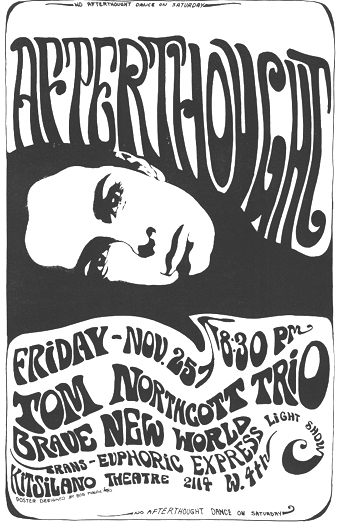PICNIC interviewed Bob Masse in early December, 1999 at his studio in Vancouver, Canada.
Could you describe what started your interest in doing posters… when did that begin?
Well, I actually was doing work for a lot of the coffeehouses in Vancouver, Canada back when Robson street was the big scene. This was in the early 60’s. Robson Street was the pre- hippie beatnik place, folkies – it was called Robsonstrausse because it had a lot of European cafés, we used to hang out at a place called the Europe Café, it was all beatniks in those days, back in ’63 & ’64. I was still going to art school at the time – A friend and I did a lot of work for the Bunkhouse, a coffeehouse in Vancouver. We did Sonny Terry, Brownie McGee, Gordon Lightfoot, Ian and Sylvia, that type of band. I don’t think we even charged them for them. We just had a running tab at the bar and got to go to all the parties afterwards. We were in our early twenties, that was enough, just to go and party with these people.

There was a place on Pender Street called Nelson’s Happening – that was when happenings were happening – the beginning of discotheques. we’d heard the word somewhere, but didn’t know what the hell it meant. I remember doing something for the Surrey A Go-Go. (laughs) You would go downstairs – I remember it was close to Bute and Pender, and Georgia area. You went down to this basement and all they had was a record player going, and a disc jockey. There’d be no band there. They’d be playing this early Rolling Stones stuff. I can always remember the early Stones peaking. Those were quite the parties.

Then there was the Afterthought which happened on 4th Avenue at the Russian Community Centre. We would go over to the Community Centre for a concert but we were more associated with the West End of Vancouver at that time. There was an enormous community of old houses in the West End in the early Sixties. And then they went through this period of tearing them all down for the high rises. The high rises you see now in the West End – it was all houses there. It was a huge community of hip people that were artists in that area. I can remember this friend and I we’d go there late at night and rummage through the houses that were all being torn down – and we’d get newl posts and staircases, doors and stained glass windows; all this beautiful stuff. We used these things to help interior decorate some of the coffehouses.
A lot of people that were living in the West End ended up getting booted out of their places and started moving over to the Kitsilano area. Kits was the other area which had a whole lot of houses and lower rents. Still does. You’d get that kind of community moving over there and the Robson Street scene sort of died out and 4th Avenue started slowly growing. I had gone down to the States a lot and so had missed out on a certain amount of what was happening in town. I remember there were just millions of people wandering around. It was like Sunset Strip or Haight Asbury. Incredible crowds of people would go down to Fourth Avenue.
I started doing posters for the coffeehouses and then I started doing ones for the Afterthought. I think I made $10-$20 a poster. You didn’t get much in those days. But again, we were actually going to Art school at the time so these were things we’d do in our off hours. It was more to get in free and party. We got to meet all the bands that were coming up.
I remember there was a place called the Peace House – about a half mile from where I live now, in Kitsilano – which was when the early peace movement and anti-war activism started to take place. They held peace rallies.
That’s where the Grateful Dead and Jefferson Airplane would stay when they came into town, so yeah, after each concert we’d always go to parties over at the Peace House. I met the Grateful Dead, partied with them and the Jefferson Airplane, Steve Miller and all of them – but they were nothing, they were just some bands from San Francisco at the time, you know – nobody knew who they were!
